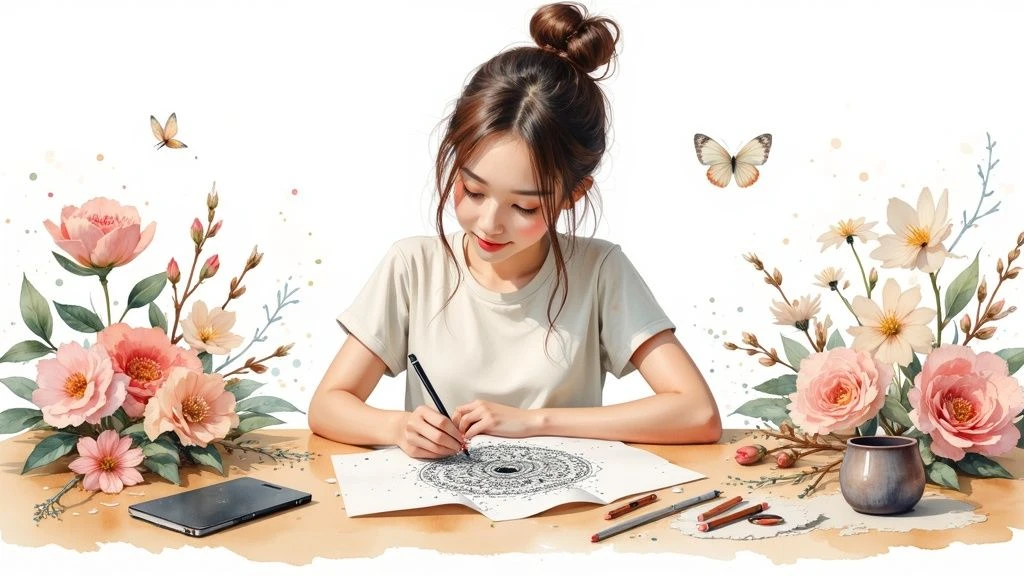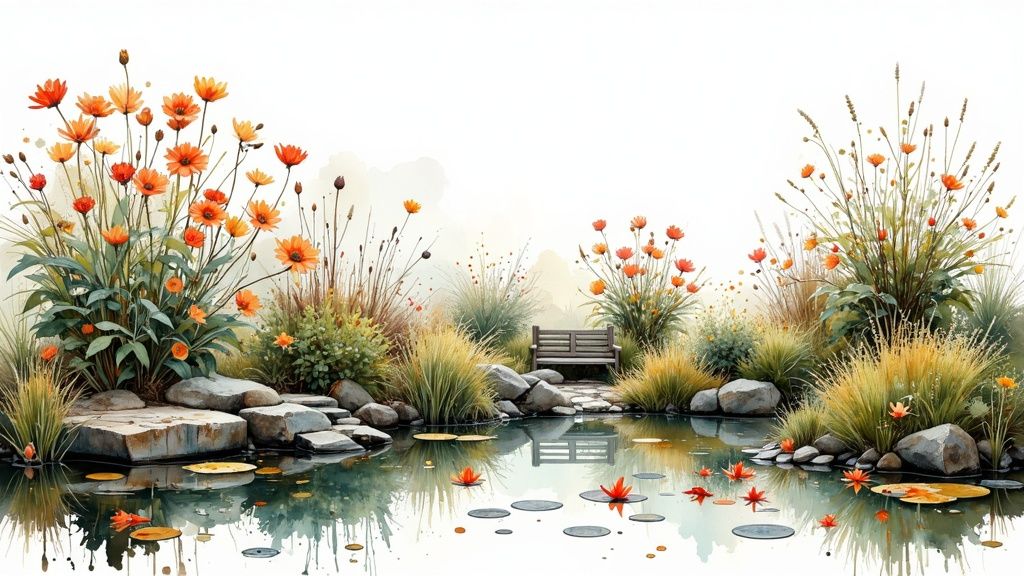Calming Coloring Pages Printable: Your Complete Stress-Relief Guide
February 4, 2025

The Science Behind Calming Coloring Pages

Remember those carefree childhood days spent with coloring books? That simple activity has found new life as a powerful stress-relief tool for adults. The reason lies in how coloring affects our brain chemistry and emotional state. When we sit down with a coloring page, we're doing more than just filling in spaces with pretty colors - we're giving our minds a much-needed break.
How Coloring Impacts the Brain
Picture yourself getting lost in coloring - your hand moving steadily, your attention focused only on staying within the lines. This state of gentle concentration activates multiple brain regions in a unique way. The repetitive motions work like a meditation, helping quiet racing thoughts. At the same time, choosing colors and working with patterns engages both analytical and creative thinking. Studies show this balanced brain activity can lower levels of cortisol, our main stress hormone.
The Role of Pattern and Color
Not all coloring pages are created equal when it comes to relaxation. Mandalas and geometric designs seem to work especially well because their structured patterns give our minds a sense of order and predictability. Colors play a big part too - blues and greens tend to feel calming, while yellows and oranges can lift our mood. By picking colors that match how we want to feel, we can customize the experience to our needs.
Calming Coloring Pages in Education and Beyond
The benefits of coloring reach far beyond personal relaxation time. Schools have started using coloring activities to help students manage stress and develop emotional awareness. One popular example is the 'Calming Down Strategies for Kids | SEL Morning Work' resource on Teachers Pay Teachers, which earned an impressive 4.77 out of 5 rating from 57 reviewers. This shows how a simple activity like coloring can become a valuable tool for emotional wellbeing across different age groups and settings. By understanding the science behind why coloring works, we can better appreciate its role in promoting mental health through creative expression.
Selecting Designs That Actually Reduce Stress

Not all coloring pages are created equal when it comes to reducing stress. While a design might catch your eye, its actual ability to help you relax depends on several key factors. Let's explore how to pick coloring pages that genuinely help calm your mind and ease tension.
The Power of Patterns
Different patterns affect our brains in unique ways. Mandalas are particularly effective - their circular, symmetrical designs naturally guide our focus inward and quiet racing thoughts. Geometric patterns provide structure that many find calming, while nature scenes tap into our natural affinity for the outdoors. Want to create your own stress-reducing designs? Check out our guide on How to master creating your own coloring pages.
Matching Designs to Stress Levels
Your current stress level should guide your choice of coloring page. When you're feeling particularly anxious, a detailed mandala can help by demanding your complete attention. For milder stress, you might prefer gentler designs like simple nature scenes with flowing lines. Having several options on hand lets you pick the right design for your current emotional state.
Complexity and Anxiety Reduction
The amount of detail in a design directly impacts its anxiety-reducing potential. Complex patterns can act like a mental reset button by fully absorbing your attention away from worrying thoughts. This deep focus creates a meditative state similar to mindfulness practice. On days when you're feeling drained, simpler designs offer a gentler way to unwind.
Choosing the Right Design for You
- For Overwhelm and Anxiety: Pick intricate mandalas or detailed cityscapes that require intense focus
- For Mild Stress and Relaxation: Choose flowing nature scenes or simple floral designs
- For Focus and Concentration: Try geometric patterns or abstract designs
- For Creative Expression: Select open-ended designs with room for interpretation
By thoughtfully selecting coloring pages based on these guidelines, you'll get more benefit from your coloring practice. Keep a mix of different designs ready so you always have the right page for your needs. The key is matching the design to how you're feeling in the moment.
Mastering Mindful Coloring Techniques

When you turn coloring into a mindful activity, you discover it's about much more than just filling in spaces with color. By focusing on the process itself rather than rushing to finish, you can tap into coloring's natural calming effects and use it as a practical way to reduce stress.
Choosing Your Coloring Tools
The supplies you select play a big role in your coloring experience. While simple crayons work perfectly well, trying different materials adds interesting dimensions to your practice. Fine-tipped markers give you precise control for detailed work, while watercolor pencils create gentle, flowing effects that work beautifully for nature scenes. Take time to test various brands of colored pencils - you'll notice each has its own unique feel and color intensity. Simply exploring these different tools can become part of your mindful practice as you pay attention to how each one feels in your hand.
The Art of Color Selection
The colors you choose can deeply affect your mood while coloring. Blues and greens tend to feel peaceful and calming, while yellows and oranges often bring out feelings of happiness and energy. Most importantly, trust your instincts about which colors feel right in the moment. When you select colors based on your current emotions rather than following strict rules, you strengthen the therapeutic benefits of your coloring practice.
Shading and Stroke Techniques
Pay close attention to each mark you make as you color, moving your tool with purpose across the page. Try changing how hard you press and which direction you move to create different textures and depths. Methods like cross-hatching, stippling, and blending can help you stay focused while adding visual interest to your work. This careful attention to your movements helps keep your mind in the present moment. Find more ideas in our guide to proven art therapy activities for anxiety and creative healing.
Creating a Calming Environment
Set yourself up for success by finding a quiet spot where you can color without interruption. Good lighting, soothing background music, and pleasant scents can all help you relax more deeply. Make sure you're sitting comfortably and take breaks when your hands get tired. By creating this peaceful space for yourself, you'll get more benefits from your coloring time and feel more refreshed afterward.
Building A Sustainable Stress-Relief Practice

Making coloring a regular part of your self-care routine takes more than just having great printable pages on hand. The real benefits come from turning this calming activity into a consistent daily practice that helps manage stress and boosts mental wellbeing.
Creating a Routine That Works For You
Start small with your coloring practice. Even five minutes of focused coloring can help you decompress and reset. Think of it like building any other healthy habit - it's better to do a little bit regularly than to set unrealistic goals you can't maintain.
Try coloring during natural breaks in your day. Maybe it's while sipping your morning coffee, during lunch, or as part of your bedtime wind-down. You could also color while enjoying a podcast or audiobook. The key is finding pockets of time that already exist in your schedule.
Overcoming Common Obstacles
We all face barriers that can derail a new habit. One of the biggest challenges is simply remembering to make time for coloring. Put your coloring supplies somewhere visible as a gentle reminder, or set an alarm on your phone to prompt you.
When life gets busy, it's tempting to skip self-care activities. But remember - a quick 5-10 minute coloring session can actually help you feel more focused and productive afterward. You might be interested in: Exploring other therapeutic art projects for mental wellness.
Setting Achievable Goals and Tracking Progress
Start with reasonable goals you know you can meet. Aim for 15 minutes of coloring two or three times per week, then slowly build up from there. Track your progress to stay motivated and see how far you've come.
- Keep it simple: Mark completed coloring sessions on your calendar
- Note your mood: Write down how you feel before and after coloring
- Make it visual: Create a progress tracker you can color in as you go
Adapting Your Practice to High-Pressure Periods
The busiest, most stressful times are when we need calming activities the most. During hectic periods, be flexible with your coloring practice. Even spending 2-3 minutes adding color to a small section of a page can provide a much-needed mental break.
Building a lasting coloring practice is about progress, not perfection. Focus on making it a natural part of your daily rhythm, working through obstacles when they arise, and adjusting your approach as needed. With time and consistency, coloring can become your go-to tool for finding moments of peace in a busy day.
Maximizing Impact Across Different Environments
Coloring pages offer proven benefits for calming and focus in many settings - from schools and workplaces to homes. When thoughtfully implemented, these simple tools build connections between people while helping each person find moments of peace. Let's explore how to make the most of coloring pages in different environments.
Calming Coloring in the Classroom
Teachers are discovering that coloring pages support students' emotional growth and learning readiness. A few minutes of quiet coloring after high-energy activities helps kids transition smoothly back to focused work. Beyond transitions, coloring integrates naturally into lessons - students might color themed pages related to current topics while practicing observation and fine motor skills. The key is guiding students to notice details like colors, patterns and textures as they work.
Workplace Wellness Initiatives
Many companies now recognize that short mental breaks boost productivity and job satisfaction. Coloring offers an easy, low-cost way for employees to reset during busy days. Setting up dedicated coloring stations gives staff a place to decompress between tasks. Group coloring sessions also help teams connect informally. The best approach is offering varied designs to match different interests and artistic confidence levels, making the activity welcoming for everyone.
Family Bonding With Coloring
Coloring together creates special family moments away from screens and schedules. Parents can choose age-appropriate pages - simpler designs for young kids and detailed patterns for older ones. The shared quiet time naturally encourages conversation while everyone expresses themselves through color choices. It's a chance for families to practice mindfulness together in a relaxed way.
Tips for Group Coloring Sessions
A few key elements help group coloring activities succeed. First, stock up on enough pages and coloring tools for everyone. Create a soothing space with comfortable seating and gentle lighting. Playing soft background music adds to the peaceful mood. You might also pose light discussion prompts about favorite colors or feelings that arise while coloring. These simple steps make coloring sessions more meaningful for all participants.
Integrating Coloring With Other Wellness Practices
Adding other relaxation techniques to your coloring practice can create an even more calming experience. Just like combining healthy foods creates a more nourishing meal, pairing coloring with complementary activities deepens their individual benefits. Let's explore some effective ways to enhance your coloring sessions.
Breathing Exercises and Coloring
When stress hits, our breathing often becomes quick and shallow. By matching your coloring rhythm to slow, deep breaths, you can actively calm your nervous system. Try this simple technique: Take a deep breath in as you select your next color, then exhale slowly while filling in a section of your design. This mindful pairing helps keep you present and relaxed.
Meditation and Coloring
Regular coloring naturally quiets busy thoughts, making it an excellent gateway to meditation. Start by sitting comfortably and taking a few centering breaths. As you begin coloring, maintain a gentle focus on the design in front of you. When your mind wanders (which is totally normal), simply notice those thoughts and guide your attention back to the peaceful act of coloring.
Aromatherapy and Coloring
Certain scents can deeply enhance your relaxation practice. Lavender and chamomile essential oils are especially good choices for creating a peaceful atmosphere. Picture yourself coloring a serene nature scene while gentle lavender scent fills the room. This combination of calming visuals and soothing aromatherapy can help melt away tension.
Music Therapy and Coloring
The right background music can make your coloring session even more restorative. Choose soft instrumental pieces, nature sounds, or gentle classical music that helps you unwind. Having this peaceful soundtrack while you color creates a mini-retreat from daily stress, letting both your eyes and ears guide you to a calmer state.
Creating Your Personalized Wellness Routine
Finding your perfect combination takes some experimentation. Start simple by adding just one element, like calming music or mindful breathing, to your coloring practice. Once that feels natural, you can try incorporating other techniques that appeal to you. Remember that short, regular sessions often work better than long, irregular ones. The key is finding what helps you relax and making it a consistent part of your self-care routine.
Ready to unlock the power of personalized calming coloring pages? Start creating your unique designs with ColorPageAI today! Create your calming coloring pages now!
Ready to start coloring?
Join ColorPage.ai today and get 5 free credits to create your own custom coloring pages!
Start creating